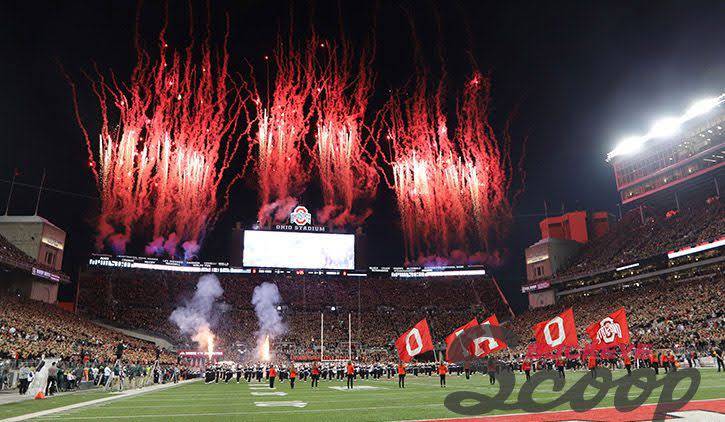Ohio State University (OSU) has a long and storied history in collegiate football, making it one of the most successful and influential programs in the nation. With a tradition dating back to 1890, OSU football has been the heart and soul of college sports in Ohio and has earned a global fanbase. For the past century, the program has been synonymous with winning, tradition, and excellence. Central to this legacy is Ohio Stadium, more commonly known as “The Horseshoe,” one of the most iconic stadiums in all of college football.
Situated on the campus of Ohio State University in Columbus, Ohio, The Horseshoe has been the site of countless unforgettable moments in college sports history. Home to the Buckeyes football team, the stadium has seen the rise of legendary players, coaches, and championship-winning teams. With a capacity of over 100,000, it ranks as one of the largest stadiums in the world, regularly drawing massive crowds to its games. As a hub of excitement, community, and tradition, it stands as a symbol of the pride and passion of OSU football.
But what would happen if something unthinkable were to occur—like a fire at Ohio Stadium? The mere idea of such an event brings forth a profound sense of concern, not only for the safety of those involved but also for the cultural and historical impact it would have on the university, its fans, and the broader sports world. To understand the gravity of such an event, we must explore the history of Ohio State football, the significance of Ohio Stadium, and the possible consequences of a crisis like a fire in this beloved venue.
The Origins of Ohio State Football
Ohio State University’s football program began in 1890, a time when college football was in its infancy. The team quickly grew in stature, becoming one of the top programs in the country. OSU’s early years were marked by steady improvement and the development of a strong fan base, but it wasn’t until the mid-20th century that the program truly solidified its position among the elite.
Under legendary head coach Woody Hayes, who served from 1951 to 1978, Ohio State became a football powerhouse. Hayes led the Buckeyes to three national championships (1954, 1957, and 1968) and was known for his tough, physical style of play. His leadership laid the foundation for the Buckeyes’ dominance in college football for decades to come. Hayes was instrumental in shaping OSU’s football culture and establishing the tradition of excellence that continues to this day.
Since Hayes’s tenure, the Buckeyes have continued to enjoy success under a succession of great coaches, including Earle Bruce, John Cooper, Jim Tressel, Urban Meyer, and Ryan Day. OSU’s dominance on the field has resulted in numerous Big Ten titles, national championships, and Heisman Trophy winners. Notable players such as Archie Griffin, Eddie George, Chris Spielman, and more recently, Ezekiel Elliott and Chase Young, have all contributed to the program’s storied history.
However, beyond the individual achievements and accolades, what has made Ohio State football so successful is the unyielding support of its fan base. Buckeye fans are some of the most passionate and loyal in the world of college sports, filling the stadium week after week with unwavering support. This fan base is what makes Ohio Stadium—The Horseshoe—such a special place.
Ohio Stadium: A Monument to College Football
Ohio Stadium, known affectionately as “The Horseshoe,” is more than just a football stadium—it is a symbol of Ohio State University’s football legacy. The stadium opened in 1922 and was initially constructed to hold 66,210 spectators, making it one of the largest college football stadiums in the country at the time. Over the years, the stadium has undergone several expansions and renovations, increasing its capacity to more than 100,000, solidifying its place as one of the largest stadiums in the world.
The unique design of the stadium, shaped like a horseshoe, has become an iconic representation of both the university and the sport of college football. The open end of the horseshoe overlooks the campus, providing a breathtaking view of the surrounding area. The sight of the stadium filled with fans in scarlet and gray, cheering on their beloved Buckeyes, is an image that represents the essence of college football itself.
The history of Ohio Stadium is also rich in tradition. The stadium has hosted countless iconic moments, from thrilling victories to heartbreaking defeats. It has witnessed legendary players and coaches, like Woody Hayes, whose presence still resonates with Buckeye fans today. The stadium has been the backdrop for Ohio State’s national championship wins, Big Ten titles, and unforgettable games against rivals like Michigan, Penn State, and Notre Dame.
One of the most significant traditions in Ohio Stadium is the “Script Ohio” performance by the Ohio State University Marching Band, which is performed during pre-game ceremonies. This spectacle, where the band spells out “Ohio” on the field, is a beloved tradition that has been part of the Ohio State football experience for generations.
Beyond football, Ohio Stadium has also hosted various other events, including concerts, political rallies, and even soccer matches. However, it is the football games that remain the centerpiece of Ohio Stadium’s significance. The stadium is not just a venue; it is a living, breathing part of Ohio State’s identity.
The Unthinkable: A Crisis at Ohio Stadium
In any stadium, the potential for a crisis—whether due to natural disasters, technical failures, or accidents—is a constant concern. However, the idea of a fire in Ohio Stadium, one of the largest and most historic venues in college football, is a deeply unsettling thought. A fire would pose significant challenges not only to the safety of those in the stadium but also to the preservation of the facility’s cultural and historical value.
In the event of a fire, the safety of the fans, players, and staff would be the top priority. Ohio Stadium, with its massive capacity, is designed with safety measures in place, including fire suppression systems, emergency exits, and trained personnel. Still, the magnitude of such an event would be overwhelming. The emotional impact on the Ohio State community would be profound. Fans who have spent decades supporting the Buckeyes would undoubtedly be devastated by the destruction of a place that holds so many memories.
The destruction of Ohio Stadium would also have a far-reaching impact on the university’s athletic programs. Football is a revenue-generating sport for OSU, and without a stadium, the university would face immense financial challenges. Additionally, the loss of such a historic venue would be a blow to the culture and tradition of Ohio State football. The university would likely have to find an alternative venue for home games, which would be a logistical and emotional challenge for both the players and the fans.
But beyond the physical loss of Ohio Stadium, a fire at the venue would represent a symbolic loss. The stadium is more than just a place to watch football—it is a place where generations of Buckeyes have gathered to celebrate victories, mourn losses, and forge lifelong memories. To lose that would be to lose a piece of Ohio State’s heart and soul.
The Response: Rebuilding and Recovery
If such a tragedy were to occur, Ohio State University and the community would undoubtedly rally to rebuild and recover. The university has a long history of overcoming adversity, and its resilience would likely drive efforts to restore Ohio Stadium or build a new facility that honors the traditions of the past while embracing the future.
In the aftermath of the crisis, it would be essential for OSU to prioritize the emotional and mental well-being of its students, faculty, staff, and fans. The university would likely hold memorial services, tribute events, and fundraisers to support the rebuilding effort and ensure that the Ohio State football program continues to thrive.
While the loss of Ohio Stadium would be a monumental setback, it would also serve as an opportunity for the Ohio State community to come together and reaffirm its commitment to the values of tradition, excellence, and perseverance that have defined the Buckeye spirit for over a century.



